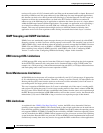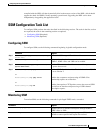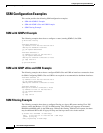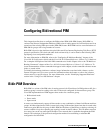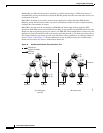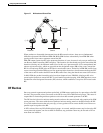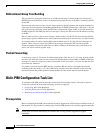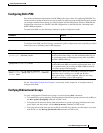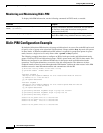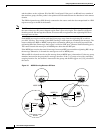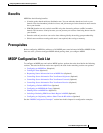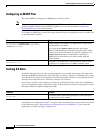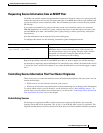
Configuring Bidirectional PIM
Bidir-PIM Configuration Task List
IPC-474
Cisco IOS IP Configuration Guide
Bidirectional Group Tree Building
The procedure for joining the shared tree of a bidirectional group is almost identical to that used in
PIM SM. One main difference is that, for bidirectional groups, the role of the DR is assumed by the DF
for the RP.
On a network with local receivers, only the router elected as the DF populates the outgoing interface list
(olist) upon receiving Internet Group Management Protocol (IGMP) join messages, and sends (*, G) join
and leave messages upstream toward the RP. When a downstream router wishes to join the shared tree,
the RPF neighbor in the PIM join and leave messages is always the DF elected for the interface leading
to the RP.
When a router receives a join or leave message, and the router is not the DF for the receiving interface,
the message is ignored. Otherwise, the router updates the shared tree in the same way as in sparse mode.
In a network where all routers support bidirectional shared trees, (S, G) join and leave messages are
ignored. There is also no need to send PIM assert messages, because the DF election procedure
eliminates parallel downstream paths from any RP. In addition, an RP never joins a path back to the
source, nor will it send any register stops.
Packet Forwarding
A router only creates (*, G) entries for bidirectional groups. The olist of a (*, G) entry includes all the
interfaces for which the router has been elected DF and that have received either an IGMP or PIM join
message. If a router is located on a sender-only branch, it will also create (*, G) state, but the olist will
not include any interfaces.
If a packet is received from the RPF interface toward the RP, the packet is forwarded downstream
according to the olist of the (*, G) entry. Otherwise, only the router that is the DF for the receiving
interface forwards the packet upstream toward the RP; all other routers must discard the packet.
Bidir-PIM Configuration Task List
To configure bidir-PIM, perform the tasks described in the following sections. The tasks in the first
section are required; the task in the remaining sections are optional.
• Configuring Bidir-PIM (Required)
• Verifying Bidirectional Groups (Optional)
• Monitoring and Maintaining Bidir-PIM (Optional)
Prerequisites
Before configuring bidir-PIM, ensure that the feature is supported on all IP multicast-enabled routers in
that domain. It is not possible to enable groups for bidir-PIM operation in a partially upgraded network.
Note Packet loops will occur immediately in networks that are only partially upgraded to support
bidir-PIM.



